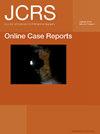Bilateral corneal opacities and surface irregularity: role of contact lenses in a case of paraproteinemic keratopathy and multiple myeloma
Q4 Medicine
引用次数: 0
Abstract
Introduction: This report features an interdisciplinary approach to diagnose and manage a case of paraproteinemic keratopathy and multiple myeloma. In addition, it suggests that rigid gas-permeable contact lenses (RGP CLs) may be a viable alternative to corneal surgery to reduce visual symptoms. Patient and clinical findings: A 57-year-old man symptomatic for progressive blur and glare over 2 years presented with an outside diagnosis of corneal dystrophy. An examination revealed bilateral diffuse subepithelial corneal crystals in conjunction with peripheral annular deposits with demarcated ridges. Corneal topography revealed central irregular astigmatism induced by these peripheral corneal opacities. Diagnosis, intervention, and outcomes: A hematological workup confirmed IgG Kappa monoclonal gammopathy and multiple myeloma. Visual rehabilitation for paraproteinemic keratopathy was achieved with RGP CLs, which are expected to maintain stable visual acuity while the patient undergoes systemic chemotherapy. Conclusions: This report emphasizes the value of thoroughly investigating dystrophy-like corneal deposits of unknown etiology as monoclonal gammopathy can have adverse or even fatal systemic implications. To the authors’ knowledge, this is the first study to directly suggest RGP CL as an adaptable and economical means to improve acuity in certain cases of paraproteinemic keratopathy without resorting to surgical intervention.双侧角膜混浊和表面不规则:隐形眼镜在副蛋白血症性角膜病变和多发性骨髓瘤中的作用
本报告采用跨学科方法诊断和处理一例副蛋白血症性角膜病变和多发性骨髓瘤。此外,该研究表明,刚性透气性隐形眼镜(RGP CLs)可能是一种可行的替代角膜手术,以减少视力症状。患者和临床表现:一名57岁男性,症状为进行性模糊和眩光超过2年,外部诊断为角膜营养不良。检查发现双侧弥漫性角膜上皮下晶体,并伴有周围环形沉积物。角膜地形图显示由周围角膜混浊引起的中央不规则散光。诊断、干预和结果:血液学检查证实IgG Kappa单克隆伽玛病和多发性骨髓瘤。使用RGP CLs可实现副蛋白性角膜病变的视力康复,预计在患者接受全身化疗时可保持稳定的视力。结论:本报告强调了彻底调查病因不明的营养不良样角膜沉积物的价值,因为单克隆伽玛病可能具有不良甚至致命的全身影响。据作者所知,这是第一个直接建议RGP CL作为一种适应性强且经济的方法来改善某些副蛋白性角膜病变病例的视力,而无需诉诸手术干预的研究。
本文章由计算机程序翻译,如有差异,请以英文原文为准。
求助全文
约1分钟内获得全文
求助全文

 求助内容:
求助内容: 应助结果提醒方式:
应助结果提醒方式:


